Psychodynamic Approach to Little Hans Case Study: A Detailed Analysis
VerifiedAdded on 2020/05/11
|6
|1399
|510
Case Study
AI Summary
This case study examines the psychodynamic approach, pioneered by Sigmund Freud, through the analysis of the 'Little Hans' case. The paper delves into key concepts such as the Oedipus complex, castration anxiety, defense mechanisms (including identification with the aggressor), and the structure of the psyche (id, ego, and superego). It explores Hans's phobia of horses in relation to his father and the unconscious mind. The evaluation section discusses the strengths, such as its ability to disclose and treat abnormal behavior and develop qualitative data, and weaknesses, including the difficulty in generalizing findings, lack of reliability, and alternative explanations for Hans's phobia. The paper also addresses the relevance of Freudian theories today, acknowledging their enduring influence while also noting criticisms and the emergence of alternative perspectives. The conclusion summarizes the treatment of Hans's phobias through a psychodynamic lens and highlights the importance of understanding concepts like psychosexual development and unconscious motives. The assignment is contributed by a student to be published on the website Desklib, a platform which provides all the necessary AI based study tools for students.

Running head: PSYCHODRYANMIC APPROACH
Case study on ‘Little Hans’
Name of the Student
Name of the University
Author Note
Case study on ‘Little Hans’
Name of the Student
Name of the University
Author Note
Paraphrase This Document
Need a fresh take? Get an instant paraphrase of this document with our AI Paraphraser
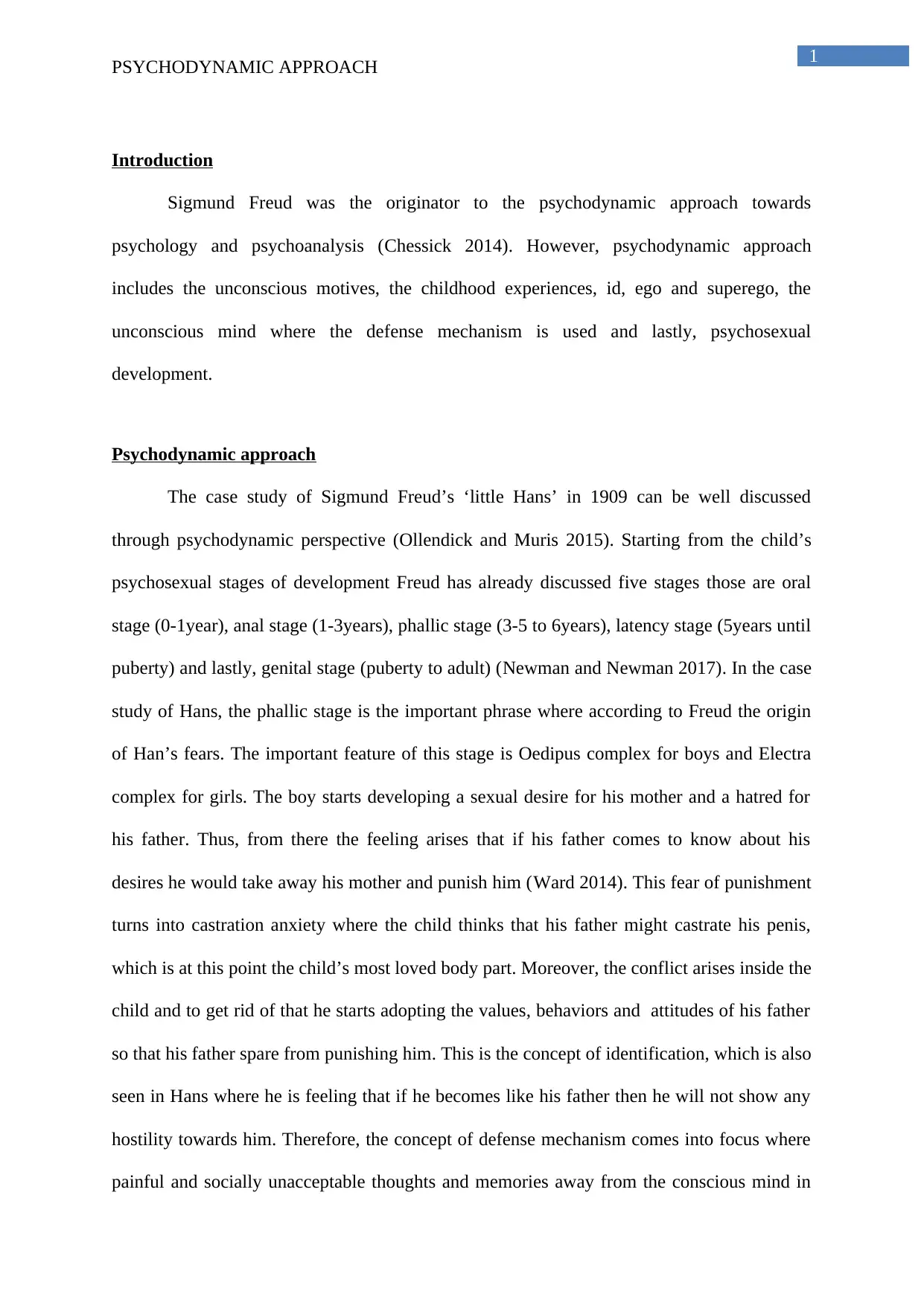
1
PSYCHODYNAMIC APPROACH
Introduction
Sigmund Freud was the originator to the psychodynamic approach towards
psychology and psychoanalysis (Chessick 2014). However, psychodynamic approach
includes the unconscious motives, the childhood experiences, id, ego and superego, the
unconscious mind where the defense mechanism is used and lastly, psychosexual
development.
Psychodynamic approach
The case study of Sigmund Freud’s ‘little Hans’ in 1909 can be well discussed
through psychodynamic perspective (Ollendick and Muris 2015). Starting from the child’s
psychosexual stages of development Freud has already discussed five stages those are oral
stage (0-1year), anal stage (1-3years), phallic stage (3-5 to 6years), latency stage (5years until
puberty) and lastly, genital stage (puberty to adult) (Newman and Newman 2017). In the case
study of Hans, the phallic stage is the important phrase where according to Freud the origin
of Han’s fears. The important feature of this stage is Oedipus complex for boys and Electra
complex for girls. The boy starts developing a sexual desire for his mother and a hatred for
his father. Thus, from there the feeling arises that if his father comes to know about his
desires he would take away his mother and punish him (Ward 2014). This fear of punishment
turns into castration anxiety where the child thinks that his father might castrate his penis,
which is at this point the child’s most loved body part. Moreover, the conflict arises inside the
child and to get rid of that he starts adopting the values, behaviors and attitudes of his father
so that his father spare from punishing him. This is the concept of identification, which is also
seen in Hans where he is feeling that if he becomes like his father then he will not show any
hostility towards him. Therefore, the concept of defense mechanism comes into focus where
painful and socially unacceptable thoughts and memories away from the conscious mind in
PSYCHODYNAMIC APPROACH
Introduction
Sigmund Freud was the originator to the psychodynamic approach towards
psychology and psychoanalysis (Chessick 2014). However, psychodynamic approach
includes the unconscious motives, the childhood experiences, id, ego and superego, the
unconscious mind where the defense mechanism is used and lastly, psychosexual
development.
Psychodynamic approach
The case study of Sigmund Freud’s ‘little Hans’ in 1909 can be well discussed
through psychodynamic perspective (Ollendick and Muris 2015). Starting from the child’s
psychosexual stages of development Freud has already discussed five stages those are oral
stage (0-1year), anal stage (1-3years), phallic stage (3-5 to 6years), latency stage (5years until
puberty) and lastly, genital stage (puberty to adult) (Newman and Newman 2017). In the case
study of Hans, the phallic stage is the important phrase where according to Freud the origin
of Han’s fears. The important feature of this stage is Oedipus complex for boys and Electra
complex for girls. The boy starts developing a sexual desire for his mother and a hatred for
his father. Thus, from there the feeling arises that if his father comes to know about his
desires he would take away his mother and punish him (Ward 2014). This fear of punishment
turns into castration anxiety where the child thinks that his father might castrate his penis,
which is at this point the child’s most loved body part. Moreover, the conflict arises inside the
child and to get rid of that he starts adopting the values, behaviors and attitudes of his father
so that his father spare from punishing him. This is the concept of identification, which is also
seen in Hans where he is feeling that if he becomes like his father then he will not show any
hostility towards him. Therefore, the concept of defense mechanism comes into focus where
painful and socially unacceptable thoughts and memories away from the conscious mind in
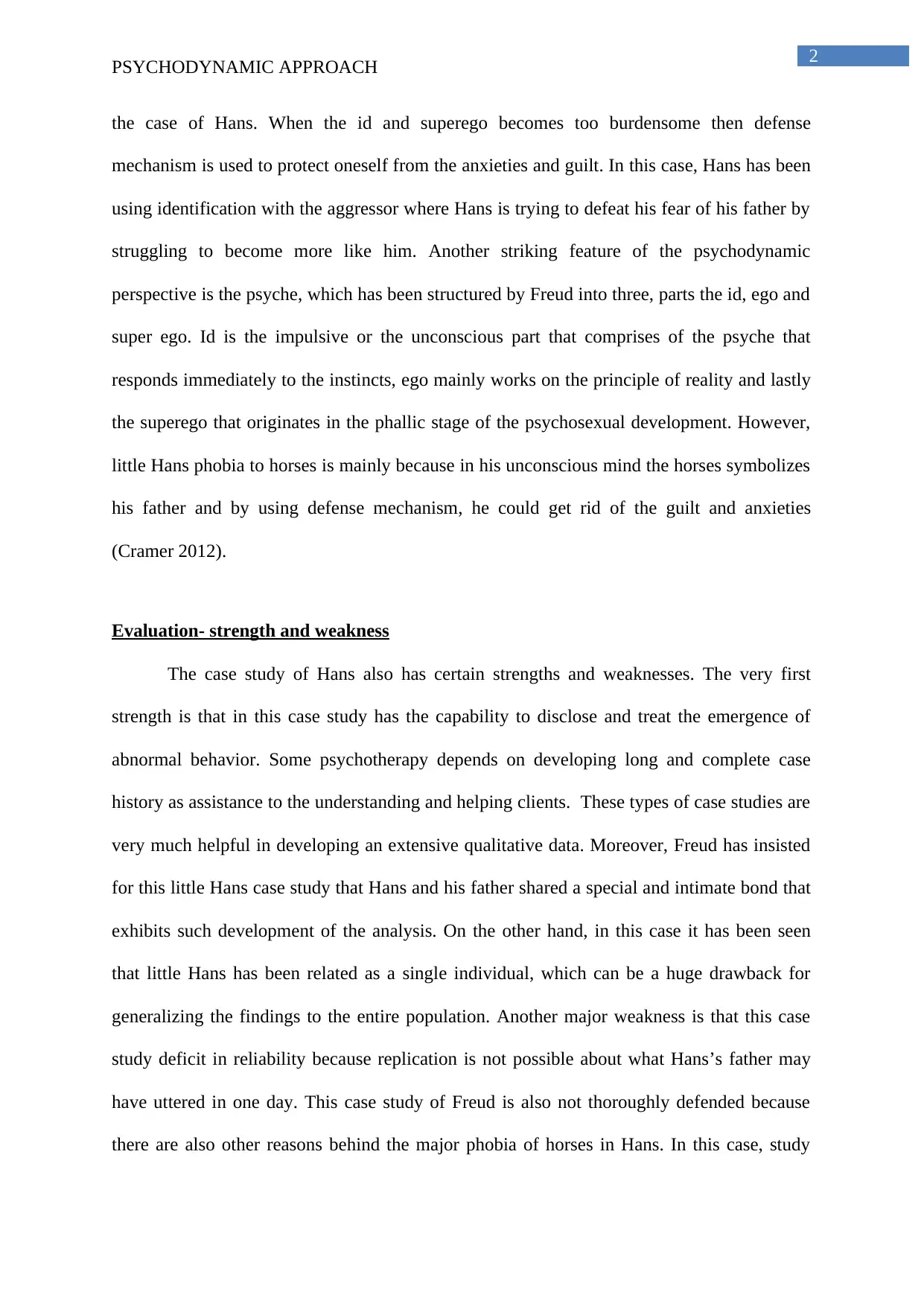
2
PSYCHODYNAMIC APPROACH
the case of Hans. When the id and superego becomes too burdensome then defense
mechanism is used to protect oneself from the anxieties and guilt. In this case, Hans has been
using identification with the aggressor where Hans is trying to defeat his fear of his father by
struggling to become more like him. Another striking feature of the psychodynamic
perspective is the psyche, which has been structured by Freud into three, parts the id, ego and
super ego. Id is the impulsive or the unconscious part that comprises of the psyche that
responds immediately to the instincts, ego mainly works on the principle of reality and lastly
the superego that originates in the phallic stage of the psychosexual development. However,
little Hans phobia to horses is mainly because in his unconscious mind the horses symbolizes
his father and by using defense mechanism, he could get rid of the guilt and anxieties
(Cramer 2012).
Evaluation- strength and weakness
The case study of Hans also has certain strengths and weaknesses. The very first
strength is that in this case study has the capability to disclose and treat the emergence of
abnormal behavior. Some psychotherapy depends on developing long and complete case
history as assistance to the understanding and helping clients. These types of case studies are
very much helpful in developing an extensive qualitative data. Moreover, Freud has insisted
for this little Hans case study that Hans and his father shared a special and intimate bond that
exhibits such development of the analysis. On the other hand, in this case it has been seen
that little Hans has been related as a single individual, which can be a huge drawback for
generalizing the findings to the entire population. Another major weakness is that this case
study deficit in reliability because replication is not possible about what Hans’s father may
have uttered in one day. This case study of Freud is also not thoroughly defended because
there are also other reasons behind the major phobia of horses in Hans. In this case, study
PSYCHODYNAMIC APPROACH
the case of Hans. When the id and superego becomes too burdensome then defense
mechanism is used to protect oneself from the anxieties and guilt. In this case, Hans has been
using identification with the aggressor where Hans is trying to defeat his fear of his father by
struggling to become more like him. Another striking feature of the psychodynamic
perspective is the psyche, which has been structured by Freud into three, parts the id, ego and
super ego. Id is the impulsive or the unconscious part that comprises of the psyche that
responds immediately to the instincts, ego mainly works on the principle of reality and lastly
the superego that originates in the phallic stage of the psychosexual development. However,
little Hans phobia to horses is mainly because in his unconscious mind the horses symbolizes
his father and by using defense mechanism, he could get rid of the guilt and anxieties
(Cramer 2012).
Evaluation- strength and weakness
The case study of Hans also has certain strengths and weaknesses. The very first
strength is that in this case study has the capability to disclose and treat the emergence of
abnormal behavior. Some psychotherapy depends on developing long and complete case
history as assistance to the understanding and helping clients. These types of case studies are
very much helpful in developing an extensive qualitative data. Moreover, Freud has insisted
for this little Hans case study that Hans and his father shared a special and intimate bond that
exhibits such development of the analysis. On the other hand, in this case it has been seen
that little Hans has been related as a single individual, which can be a huge drawback for
generalizing the findings to the entire population. Another major weakness is that this case
study deficit in reliability because replication is not possible about what Hans’s father may
have uttered in one day. This case study of Freud is also not thoroughly defended because
there are also other reasons behind the major phobia of horses in Hans. In this case, study
⊘ This is a preview!⊘
Do you want full access?
Subscribe today to unlock all pages.

Trusted by 1+ million students worldwide
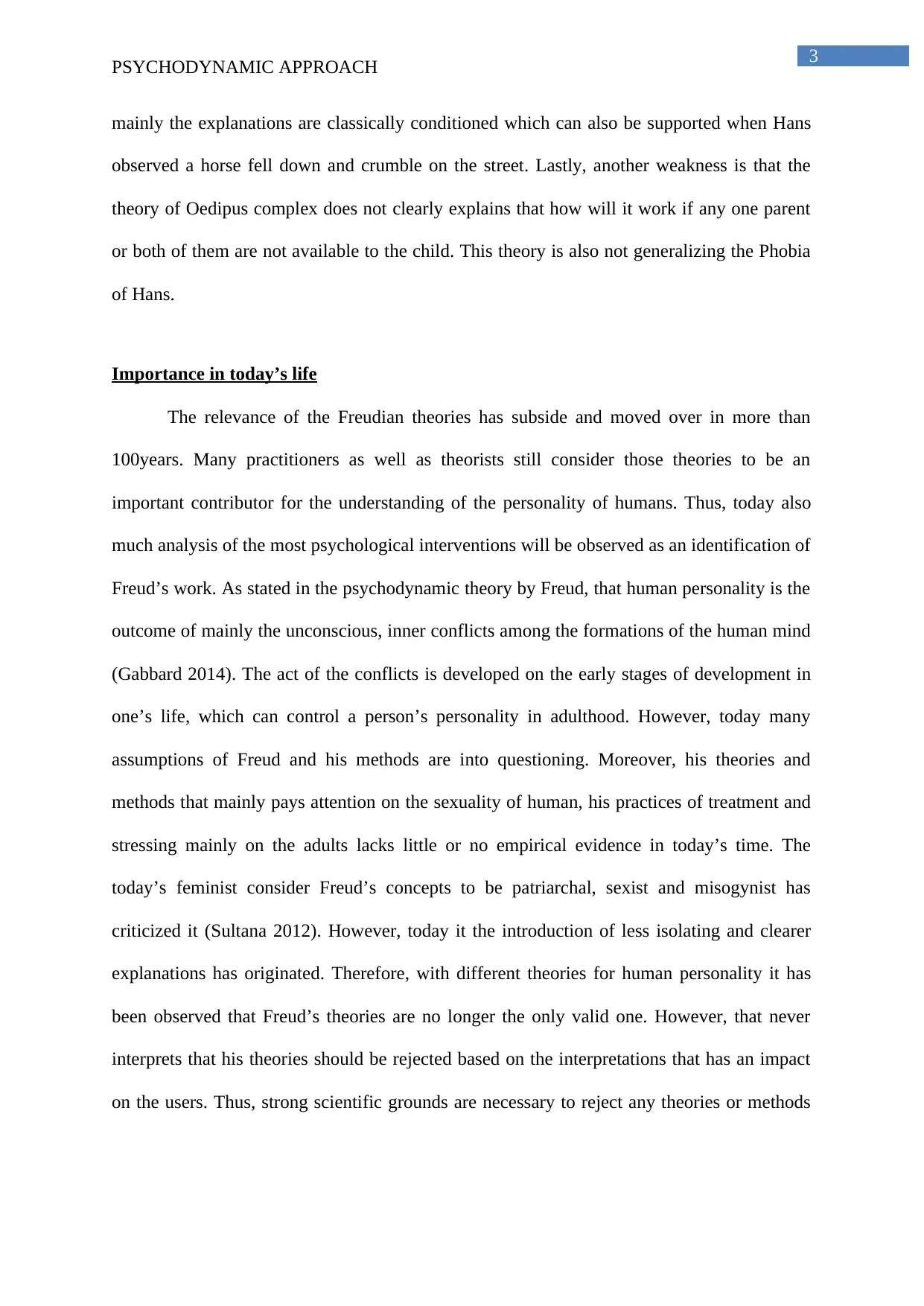
3
PSYCHODYNAMIC APPROACH
mainly the explanations are classically conditioned which can also be supported when Hans
observed a horse fell down and crumble on the street. Lastly, another weakness is that the
theory of Oedipus complex does not clearly explains that how will it work if any one parent
or both of them are not available to the child. This theory is also not generalizing the Phobia
of Hans.
Importance in today’s life
The relevance of the Freudian theories has subside and moved over in more than
100years. Many practitioners as well as theorists still consider those theories to be an
important contributor for the understanding of the personality of humans. Thus, today also
much analysis of the most psychological interventions will be observed as an identification of
Freud’s work. As stated in the psychodynamic theory by Freud, that human personality is the
outcome of mainly the unconscious, inner conflicts among the formations of the human mind
(Gabbard 2014). The act of the conflicts is developed on the early stages of development in
one’s life, which can control a person’s personality in adulthood. However, today many
assumptions of Freud and his methods are into questioning. Moreover, his theories and
methods that mainly pays attention on the sexuality of human, his practices of treatment and
stressing mainly on the adults lacks little or no empirical evidence in today’s time. The
today’s feminist consider Freud’s concepts to be patriarchal, sexist and misogynist has
criticized it (Sultana 2012). However, today it the introduction of less isolating and clearer
explanations has originated. Therefore, with different theories for human personality it has
been observed that Freud’s theories are no longer the only valid one. However, that never
interprets that his theories should be rejected based on the interpretations that has an impact
on the users. Thus, strong scientific grounds are necessary to reject any theories or methods
PSYCHODYNAMIC APPROACH
mainly the explanations are classically conditioned which can also be supported when Hans
observed a horse fell down and crumble on the street. Lastly, another weakness is that the
theory of Oedipus complex does not clearly explains that how will it work if any one parent
or both of them are not available to the child. This theory is also not generalizing the Phobia
of Hans.
Importance in today’s life
The relevance of the Freudian theories has subside and moved over in more than
100years. Many practitioners as well as theorists still consider those theories to be an
important contributor for the understanding of the personality of humans. Thus, today also
much analysis of the most psychological interventions will be observed as an identification of
Freud’s work. As stated in the psychodynamic theory by Freud, that human personality is the
outcome of mainly the unconscious, inner conflicts among the formations of the human mind
(Gabbard 2014). The act of the conflicts is developed on the early stages of development in
one’s life, which can control a person’s personality in adulthood. However, today many
assumptions of Freud and his methods are into questioning. Moreover, his theories and
methods that mainly pays attention on the sexuality of human, his practices of treatment and
stressing mainly on the adults lacks little or no empirical evidence in today’s time. The
today’s feminist consider Freud’s concepts to be patriarchal, sexist and misogynist has
criticized it (Sultana 2012). However, today it the introduction of less isolating and clearer
explanations has originated. Therefore, with different theories for human personality it has
been observed that Freud’s theories are no longer the only valid one. However, that never
interprets that his theories should be rejected based on the interpretations that has an impact
on the users. Thus, strong scientific grounds are necessary to reject any theories or methods
Paraphrase This Document
Need a fresh take? Get an instant paraphrase of this document with our AI Paraphraser
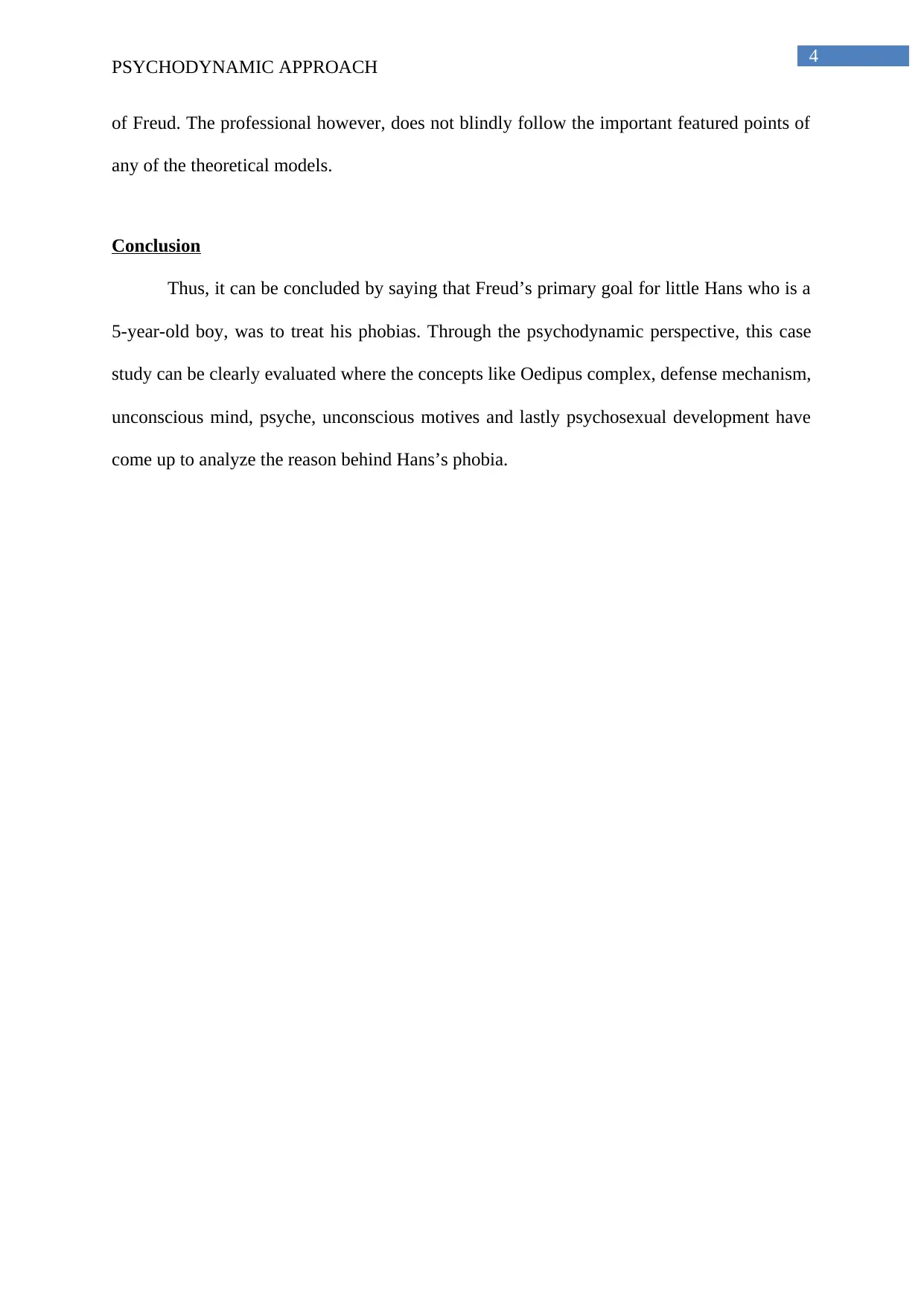
4
PSYCHODYNAMIC APPROACH
of Freud. The professional however, does not blindly follow the important featured points of
any of the theoretical models.
Conclusion
Thus, it can be concluded by saying that Freud’s primary goal for little Hans who is a
5-year-old boy, was to treat his phobias. Through the psychodynamic perspective, this case
study can be clearly evaluated where the concepts like Oedipus complex, defense mechanism,
unconscious mind, psyche, unconscious motives and lastly psychosexual development have
come up to analyze the reason behind Hans’s phobia.
PSYCHODYNAMIC APPROACH
of Freud. The professional however, does not blindly follow the important featured points of
any of the theoretical models.
Conclusion
Thus, it can be concluded by saying that Freud’s primary goal for little Hans who is a
5-year-old boy, was to treat his phobias. Through the psychodynamic perspective, this case
study can be clearly evaluated where the concepts like Oedipus complex, defense mechanism,
unconscious mind, psyche, unconscious motives and lastly psychosexual development have
come up to analyze the reason behind Hans’s phobia.
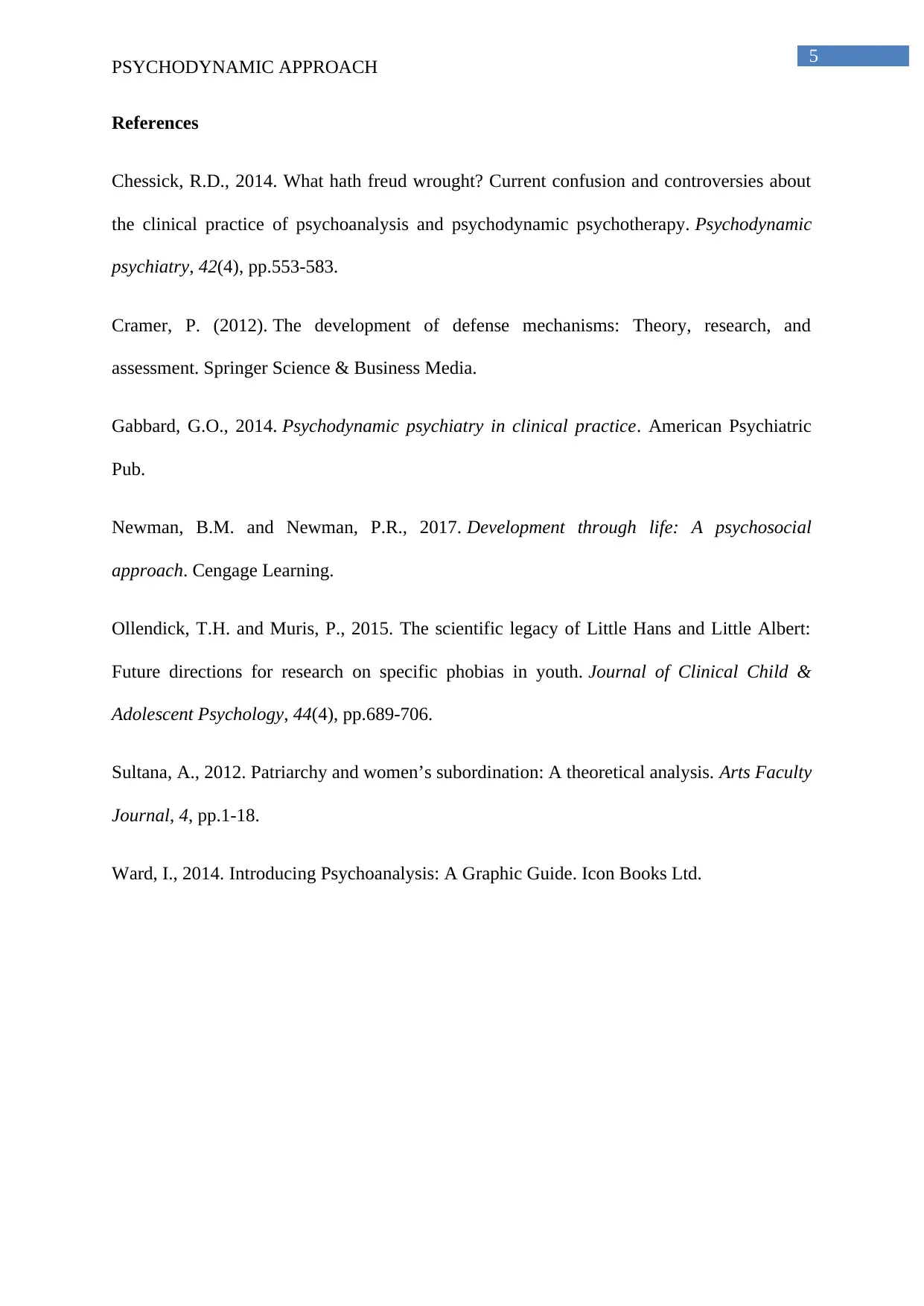
5
PSYCHODYNAMIC APPROACH
References
Chessick, R.D., 2014. What hath freud wrought? Current confusion and controversies about
the clinical practice of psychoanalysis and psychodynamic psychotherapy. Psychodynamic
psychiatry, 42(4), pp.553-583.
Cramer, P. (2012). The development of defense mechanisms: Theory, research, and
assessment. Springer Science & Business Media.
Gabbard, G.O., 2014. Psychodynamic psychiatry in clinical practice. American Psychiatric
Pub.
Newman, B.M. and Newman, P.R., 2017. Development through life: A psychosocial
approach. Cengage Learning.
Ollendick, T.H. and Muris, P., 2015. The scientific legacy of Little Hans and Little Albert:
Future directions for research on specific phobias in youth. Journal of Clinical Child &
Adolescent Psychology, 44(4), pp.689-706.
Sultana, A., 2012. Patriarchy and women’s subordination: A theoretical analysis. Arts Faculty
Journal, 4, pp.1-18.
Ward, I., 2014. Introducing Psychoanalysis: A Graphic Guide. Icon Books Ltd.
PSYCHODYNAMIC APPROACH
References
Chessick, R.D., 2014. What hath freud wrought? Current confusion and controversies about
the clinical practice of psychoanalysis and psychodynamic psychotherapy. Psychodynamic
psychiatry, 42(4), pp.553-583.
Cramer, P. (2012). The development of defense mechanisms: Theory, research, and
assessment. Springer Science & Business Media.
Gabbard, G.O., 2014. Psychodynamic psychiatry in clinical practice. American Psychiatric
Pub.
Newman, B.M. and Newman, P.R., 2017. Development through life: A psychosocial
approach. Cengage Learning.
Ollendick, T.H. and Muris, P., 2015. The scientific legacy of Little Hans and Little Albert:
Future directions for research on specific phobias in youth. Journal of Clinical Child &
Adolescent Psychology, 44(4), pp.689-706.
Sultana, A., 2012. Patriarchy and women’s subordination: A theoretical analysis. Arts Faculty
Journal, 4, pp.1-18.
Ward, I., 2014. Introducing Psychoanalysis: A Graphic Guide. Icon Books Ltd.
⊘ This is a preview!⊘
Do you want full access?
Subscribe today to unlock all pages.

Trusted by 1+ million students worldwide
1 out of 6
Related Documents
Your All-in-One AI-Powered Toolkit for Academic Success.
+13062052269
info@desklib.com
Available 24*7 on WhatsApp / Email
![[object Object]](/_next/static/media/star-bottom.7253800d.svg)
Unlock your academic potential
Copyright © 2020–2025 A2Z Services. All Rights Reserved. Developed and managed by ZUCOL.





